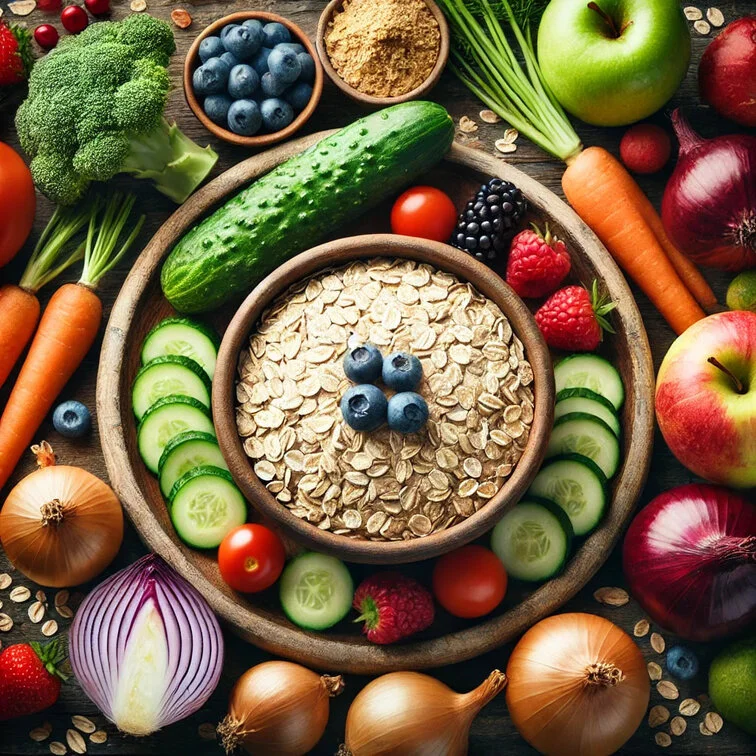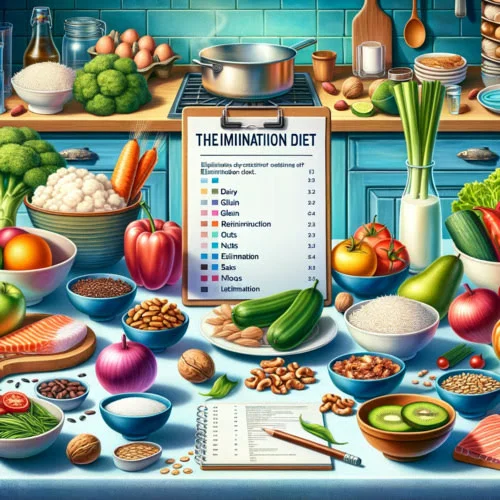The hypolipidemic diet is a specialized nutritional approach aimed at reducing blood lipid levels, such as cholesterol and triglycerides. High lipid levels are a major risk factor for cardiovascular diseases, including atherosclerosis, which can lead to serious complications like heart attacks and strokes.
This diet plays a key role in preventing atherosclerosis by reducing the intake of animal fats and increasing the proportion of polyunsaturated fatty acids and fiber in the diet. This approach not only helps to lower cholesterol levels but also promotes balanced nutrition, which in turn improves overall health and reduces the risk of cardiovascular diseases.
Key Principles of the Hypolipidemic Diet

One of the key principles of the hypolipidemic diet is minimizing the intake of animal fats. These fats, which contain saturated fatty acids, contribute to elevated cholesterol levels in the blood, thereby increasing the risk of atherosclerosis. The diet recommends replacing such fats with sources of polyunsaturated fatty acids found in plant oils, fish, and nuts.
Another important aspect of this diet is increasing the consumption of fiber-rich foods. Vegetables, fruits, and whole grains not only aid digestion but also help lower blood lipid levels, maintaining the health of the cardiovascular system.
Fractional eating is another significant principle of the hypolipidemic diet. Regular small meals (5-6 times a day) help maintain stable blood sugar levels and prevent overeating, contributing to the effective reduction of triglycerides and cholesterol. This approach also helps to avoid sharp energy fluctuations and supports optimal metabolism.
Allowed and Forbidden Foods
The hypolipidemic diet requires a strict selection of foods that help reduce lipid levels and prevent the development of atherosclerosis. The diet should primarily consist of foods rich in fiber and polyunsaturated fatty acids, which contribute to lowering cholesterol and triglycerides.
Allowed foods include:
- Vegetables and fruits: Cabbage, cucumbers, zucchini, tomatoes, kiwi, citrus fruits, apples, pomegranates, and others. These foods are rich in fiber and antioxidants, which help cleanse the blood vessels and improve metabolism.
- Lean meats: Chicken, turkey, and other types of lean meats are good sources of protein without excess saturated fats.
- Plant oils: Olive oil, flaxseed oil, and sunflower oil are sources of beneficial polyunsaturated fatty acids that help lower cholesterol levels.
- Whole grain products: Rye bread and whole grain cereals provide the body with necessary fiber and slow-digesting carbohydrates, which help maintain stable blood sugar levels.
Forbidden foods include:
- Fatty meats and offal: Pork, lamb, lard, sausages, offal (liver, kidneys), which contain high levels of saturated fats and cholesterol.
- Sweets and pastries: Cakes, pastries, chocolate, which are high in sugar and trans fats, contributing to elevated triglyceride levels.
- Carbonated drinks and alcohol: These drinks contain a lot of sugar and empty calories, leading to lipid metabolism disorders and weight gain.
Adhering to the recommendations on food selection in the hypolipidemic diet is a crucial step towards lowering lipid levels in the blood and maintaining cardiovascular health.
Meal Schedule

The meal schedule is an important component of the hypolipidemic diet, contributing to the effective reduction of lipid levels and the maintenance of cardiovascular health. The main principle is fractional meals—eating frequently and in small portions, which helps to maintain stable blood sugar levels and avoid overeating.
Sample Weekly Menu
Monday
- Breakfast: Oatmeal with berries, green tea.
- First snack: Pear or apple.
- Lunch: Vegetable soup, lean chicken fillet baked with vegetables, rye bread.
- Second snack: A handful of nuts and freshly squeezed juice.
- Dinner: Steamed fish with a salad of fresh vegetables, a glass of kefir.
Tuesday
- Breakfast: Egg white omelet with greens, black tea.
- First snack: Grapefruit.
- Lunch: Boiled turkey with buckwheat, a salad of fresh vegetables.
- Second snack: A few whole-grain crackers and yogurt.
- Dinner: Stewed vegetables with chicken fillet, a glass of herbal tea.
Wednesday
- Breakfast: Cottage cheese casserole with dried fruits, green tea.
- First snack: Orange.
- Lunch: Fish baked with vegetables, a cabbage and carrot salad, whole-grain bread.
- Second snack: A glass of fat-free yogurt.
- Dinner: Borscht without meat with low-fat sour cream, baked chicken breast.
Thursday
- Breakfast: Brown rice with apple and cinnamon, green tea.
- First snack: Fruit salad.
- Lunch: Pumpkin soup, boiled veal with a vegetable garnish.
- Second snack: Pear or kiwi.
- Dinner: Baked fish with vegetables, a glass of kefir.
Friday
- Breakfast: Oatmeal with dried fruits, black tea.
- First snack: Greek salad with olive oil.
- Lunch: Buckwheat with chicken fillet, a salad of fresh vegetables.
- Second snack: Yogurt with berries.
- Dinner: Stewed fish with vegetables, herbal tea.
Saturday
- Breakfast: Omelet with vegetables, rye bread, green tea.
- First snack: Fresh fruit salad.
- Lunch: Borscht with vegetable broth, chicken breast with buckwheat.
- Second snack: Orange or grapefruit.
- Dinner: Baked turkey with vegetables, a glass of kefir.
Sunday
- Breakfast: Cottage cheese casserole with berries, green tea.
- First snack: Pear or apple.
- Lunch: Fish soup, boiled fish with a vegetable garnish.
- Second snack: A few nuts and freshly squeezed juice.
- Dinner: Stewed vegetables with chicken fillet, a glass of yogurt.
Tips for a Balanced Diet
- Focus on plant-based foods: Include vegetables and fruits in every meal as they are rich in fiber, vitamins, and antioxidants. These help reduce cholesterol levels and maintain stable blood sugar levels.
- Meal regularity: Eat 5-6 times a day in small portions. This helps avoid overeating and maintain a constant energy level.
- Healthy fats: Use plant oils such as olive or flaxseed instead of saturated animal fats. This helps reduce triglyceride and cholesterol levels.
- Proper cooking methods: Prefer steaming, baking, or stewing. Avoid frying as it increases the amount of harmful fats.
- Control over salt and sugar intake: Minimize the addition of salt and sugar to dishes. This not only reduces the risk of cardiovascular diseases but also helps maintain normal blood pressure.
Following these recommendations will not only help effectively lower lipid levels but also support long-term health.
The Benefits of a Hypolipidemic Diet for Health

The hypolipidemic diet has a significant positive impact on health, particularly in reducing cholesterol and triglyceride levels, preventing cardiovascular diseases, and diabetes, and maintaining overall physical activity.
Impact on Cholesterol and Triglyceride Levels
One of the main advantages of the hypolipidemic diet is its ability to lower cholesterol and triglyceride levels in the blood. By limiting the intake of saturated fats and trans fats, this diet helps to reduce the concentration of low-density lipoproteins (LDL), commonly known as “bad” cholesterol. At the same time, it increases the proportion of high-density lipoproteins (HDL), which help remove excess cholesterol from the blood vessels. Triglyceride levels are also reduced by lowering the intake of sugar and refined carbohydrates, improving the lipid profile and decreasing the risk of atherosclerosis.
Prevention of Cardiovascular Diseases and Diabetes
The hypolipidemic diet also plays a key role in preventing cardiovascular diseases. By reducing cholesterol and triglyceride levels, it lowers the risk of atherosclerotic plaque formation, which can lead to heart attacks and strokes. Additionally, this diet helps control blood sugar levels, which is especially important for the prevention and management of type 2 diabetes. Regular consumption of fiber-rich foods, such as vegetables, fruits, and whole grains, helps maintain normal blood glucose levels, preventing sharp sugar spikes and improving insulin sensitivity.
Recommendations for Physical Activity
Physical activity is an important complement to the hypolipidemic diet. Regular moderate exercise, such as walking, swimming, or yoga, helps speed up metabolism, promotes fat burning, and improves the lipid profile. For the best results, it is recommended to combine the diet with physical exercise for at least 30 minutes a day. This will not only enhance the effects of the diet but also improve overall well-being, boost energy levels, and strengthen the cardiovascular system.
In summary, the hypolipidemic diet and physical activity are powerful tools for maintaining health, preventing serious diseases, and improving quality of life.
Conclusion
The hypolipidemic diet is an effective approach to reducing blood lipid levels and preventing cardiovascular diseases, including atherosclerosis and diabetes. The main principles of the diet include minimizing the intake of animal fats, increasing the proportion of polyunsaturated fatty acids and fiber, and adhering to a fractional meal schedule.
Regular consumption of fiber-rich foods and healthy fats helps to lower cholesterol and triglyceride levels, significantly reducing the risk of developing cardiovascular diseases. It is also important to note that combining the hypolipidemic diet with moderate physical activity not only improves the lipid profile but also helps to maintain overall health and energy levels.
For long-term health improvement, it is recommended to adhere to this diet on an ongoing basis, incorporating its principles into daily eating habits. Gradual changes in dietary habits and regular physical exercise will help maintain normal cholesterol and triglyceride levels and protect against serious diseases, ultimately improving the quality of life.














